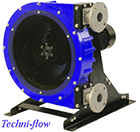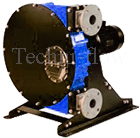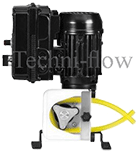Peristaltics pumps
pumps@techni-flow-pumps.com
Techni-flow peristaltic pumps are designed to correspond as closely as possible to the requirements of manufacturers:
Peristaltic pump for the chemical industry
Peristaltic pump for the environment industry
Pump for the food industry.
Peristaltic pump technology can pump high viscosity products up to 30,000 cps.
This range of pumps allows dry running without deterioration.
As the flow rate is strictly proportional to the speed of rotation, a dosing function is very easy to perform.
the available flow range is extremely wide, from the lowest flow rate of a few ml liters / h to more than 36m³ / h.
Oil-free peristaltic pump
The TFFMP hose peristaltic pump is suitable for a wide variety of applications, for high viscosity fluids, or abrasive.
This peristaltic pump is suitable for all industrial fields, chemical, food, mining, construction, environment, etc.
-Lubrication of the peristaltic tube with grease.
-Output pressure up to 8 bar
High pressure peristaltic pumps
The TFRBT peristaltic pump is the pump for extreme situations:
it is capable of producing an outlet pressure of 15 bar, for fluids of high viscosities.
In addition, this peristaltic pump has been studied to resist the abrasion of the most difficult fluid.
-lubrication of the oil peristaltic tube.
-Output pressure up to 15 bar
Laboratory peristaltic pumps
This peristaltic pump is used as a metering pump, in fact the adjustment of the volume of fluid to be pumped is adjustable, moreover this roller peristaltic pump is able to operate over a long period with great reliability.
The pump hose can be easily disassembled for maintenance operations.
Peristaltic pumps for sewage sludge
Filter press force-feeding application.
The flow rate requested at the start of pumping is 4m3 / h, with a pressure rise up to 15bar.
The flow must be adjusted automatically to maintain this maximum pressure at the end of the pressing process, until the pump stops.
The peristaltic pump chosen for this application case is a TFRBT60 DN65 pump equipped with a speed reducer at 23 rpm with a frequency converter controlled by a pressure sensor, in the pressure maintenance phase the speed is reduced to minimum
Operating principle of peristaltic pumps
the principle of pumping is very simple and particularly widespread in nature: for example, the digestive tract works according to the principle of peristalsis. Technically the peristaltic pump (also called roller pump) is designed from a flexible tube that is pressed through several rollers.
The fluid is expelled from the tube during the squeezing phase, the suction occurs thanks to the elasticity of the peristaltic tube which returns to its natural diameter once the roller is released.
Peristaltic pump for chemical effluent treatment
A chemical effluent treatment plant from a surface treatment bath needs to transfer corrosive sludge of very high viscosity varying up to 45,000 cpo under certain conditions.
The goal is to feed a filter press.
For this particular application, the peristaltic roller pump has been fitted with a feed hopper with an endless screw in which and to empty the viscous slurry.
The endless screw feeds the peristaltic pump in cases where the viscosity of the slurry increases, which prevents de-priming of the peristaltic pump.
Peristaltic pump for hydroelectric dam depollution
Dans les barrages hydroélectriques la production d’électricité est produite par plusieurs turbines, ces turbines comportent un circuit hydraulique de graissage et lubrification des paliers qui génèrent un certain nombre de fuites d’huile et graisses.
Cette huile est canalisée dans une fosse en fond de barrage qu’il convient de pomper pour assurer son traitement.
L’huile étant mélangée a de l’eau et comptant de nombreuses particules, une pompe péristaltique à galet et utilisé. Cette pompe péristaltique sera placée le plus haut possible par rapport au niveau de l’eau pour éviter toute inondation.
Peristaltic pump for ceramic slip
Slip pumping in the ceramic industry is problematic because of the abrasiveness of the raw material to be pumped: slip, this material used in the manufacture of ceramic objects is a mixture of water and different clays. ingredients.
This ceramic slip is extremely abrasive and tends to wear out standard positive displacement pump housings.
For slurry pumping, peristaltic pump technology is effective, the pump will be sized to produce the requested flow rate at very low rotational speed so as not to prematurely wear the tube.
Peristaltic pump for Joint, plaster and plaster machine
To improve the production yields of joints in the building industry, our small peristaltic pump is used more and more:
In the building industry, the joints used for finishing stone or brick facades are based on grout, mortar , plaster etc.
These seals are very viscous and abrasive and the quality and finish of the application depends on the precision and regularity of pumping.
The peristatic pump is equipped with a variable speed drive that adjusts the pump flow rate to the desired production speed. cleaning the peristaltic pump. Between two seal materials used, the peristaltic pump is very easily cleaned by recirculated pheasants with water or a cleaning fluid to suit the nature of the seal.
The nature of the peristaltic tube will be determined based on the chemical compatibility with the chemical components of the seal and the cleaning fluid
Peristaltic pump for activated carbon
The activated carbon slip is a suspension of powdered activated carbon. Its use is in the water treatment sector.
Activated carbon in suspension requires certain precautions when choosing which pump technique to use.
Powdered activated carbon is corrosive, abrasive and depending on the concentrations used, the activated carbon slurry can be viscous.
In water treatment stations, peristaltic pumps can be used.
In these applications a dosing function is often required, the peristaltic technology being volumetric, has very good repeatability of the flow rate per revolution whatever the operating conditions. Depending on the daily operating times, it will be necessary to adapt the speed of rotation according to the acceptable life of the tube, in fact, the faster the pump runs, the greater the effect of abrasion on the tube may be.
Alternative to peristaltic pump
Manufacturers have at their disposal a multitude of pump technologies which would seem to adapt to this application:
Electric or pneumatic diaphragm pumps have all the conditions for performing the function, but the dosing function is in our case more precise with peristaltic technology.
In fact, the pneumatic pump can perform this function with a counting kit, but the pump cannot stop in the middle of the stroke, the precision is within a displacement.
Technical data sheets for peristaltic pumps
You will find attached a complete list of technical data sheets concerning the techni-flow tube crushing peristaltic pump range:
two types of files are at your disposal, one concerning the performance of the peristaltic pump, the other the dimensions and space requirement.
of the techni-flow peristaltic pump. Other documents are also available on request.
Do not hesitate to contact us if the information you need is not present on one of the technical sheets below.
The main data are listed in the pages of each standard pump range for small flow rates, choose from the TFAMP peristaltic pump range.
for medium flow rates the TF FMP peristaltic pump range and for maximum flow rates the TF-FMP peristaltic pump range.
In the particular case where the required pressure exceeds 8 bar, the TF-RBT peristaltic pump range will push the outlet pressure up to 15 bar
peristaltic pumps type TF-AMP
tf-amp10 pump
tf-amp13 pump
tf-amp16 pump
tf-amp19 pump
tf-amp22 pump
peristaltic pumps type TF-FMP
tf-FMP30 pump
tf-FMP40 pump
tf-FMP50 pump
tf-FMP60 pump
tf-FMP70 pump
peristaltic pumps TYPE TF-RBT
tf-RBT40 pump
tf-RBT60 pump
tf-RBT70 pump
the viscosity of the fluid is a very important parameter in the choice of the type of peristaltic pumps, in fact the higher the viscosity, the more the speed of rotation of the pump will have to be reduced, it will therefore be advisable to choose a larger tube diameter.
The curve you will find in this document is provided for guidance only.
without the case where the viscosities of the fluid is less than 10,000cpo, a visit to the application pages of pneumatic diaphragm pumps is required.
Curve of the rotational speeds of the peristaltic pump as a function of the viscosity of the fluid..
A second system for optimizing the suction capacity of the peristaltic pump has been added by releasing the housing of the peristaltic pump.
In the case of pumping fluid with extreme viscosities, the peristaltic tube risks not returning to its original shape after the roller has passed, the presence of an additional high vacuum in the casing forces the tube to regain its diameter and creates a vacuum.
extreme at the suction of the peristaltic pump.
To further improve the pumping performance, the peristaltic pump has been greatly dimensioned and therefore the speed of rotation of the peristaltic tube has been reduced.
Pump for Groundwater Sampling
A piezometric well is an unexploited well that allows the measurement of the groundwater level, the sample must be taken by a surface pump because the well is small in diameter.
A small peristaltic metering pump was chosen for this application which requires maximum suction height in cases where the water table is at its lowest level.
The peristaltic pump has the advantage of not deteriorating in the event of dry running.
Concrete and cement pump
Concrete is virtually impossible to pump with a standard industrial pump, it is a very dense, abrasive and viscous fluid.
its composition is very variable and evolves with the new uses that industrialists in the building find it.
Mainly concrete is composed of sand, water, gravel and limestone which when mixed causes a chemical reaction which produces a material similar to stone.
The new concretes are mixed with many liquid or solid additives, such as fibers of different natures, or powders, so as to improve the basic mechanical characteristics.
As peristaltic concrete pumps are positive-displacement, they precisely dose concrete at the same time as pumping, which improves production quality control.
Pumping black water in marinas.
Recreational vessels are equipped with black water holding tanks that should be emptied regularly, marinas must therefore be equipped with a pumping system in order to empty these tanks.
The distance between the pump and the vessel is important, generating significant pressure drops at the pump suction.
The choice of a peristaltic pump allows a maximum suction capacity even, a pumping of large particle diameter.
The peristaltic pump has the ability to run dry without deterioration which facilitates priming in difficult conditions.
How to choose your peristaltic pump:
BY FLOW:
The size of the peristaltic pump mainly depends on the diameter of the peristaltic tube.
A tube diameter corresponds to a cylinder capacity, the faster the pump will turn, the greater the flow will be.
The lifespan of a peristaltic tube being proportional to the rotational speed, for intermittent or light use a high rotational speed range can be used, for intensive use the rotational speed will be reduced.
The size of the pump also depends on the viscosity of the fluid: for a liquid fluid the speed of rotation can be maximum, for a viscous fluid, a minimum speed will be used.
The abrasiveness of the fluid accelerates the wear of the tube, so for an abrasive fluid the speed will also be reduced. The outlet pressure also influences the longevity of the tube. Finally, certain delicate fluids require a reduced speed of rotation so as not to distort the characteristics of the fluid.
To facilitate the selection of the most suitable tube for the proper functioning of your peristaltic pump, we have made a preselection corresponding to the most common applications.
Natural rubber: our standard.
As the life curves show it has the best durability, very good abrasion resistance, not suitable for pumping corrosive fluid.
NBR also called nitrile rubbers, this material is mainly suitable for pumping oil, this tube is also available in a version for food fluid.
HYPALON tube
the hypalon tube is particularly resistant to chemical fluid, even concentrated, such as nitric acid hydrochloric acid soda etc it is a chlorinated sulfonated rubber
Choose the best tube for your peristaltic pump.
To facilitate the selection of the most suitable tube for the proper functioning of your peristaltic pump, we have made a preselection corresponding to the most common applications.
Natural rubber: our standard.
As the life curves show it has the best durability, very good abrasion resistance, not suitable for pumping corrosive fluid.
NBR also called nitrile rubbers, this material is mainly suitable for pumping oil, this tube is also available in a version for food fluid.
HYPALON tube
the hypalon tube is particularly resistant to chemical fluid, even concentrated, such as nitric acid hydrochloric acid soda etc it is a chlorinated sulfonated rubber
Accessories:
We offer a range of accessories that allow you to increase the range of use of your peristaltic pump:
Vacuuming the crankcase:
The evacuation of the casing allows the tube to resume its shape which allows pumping.
This accessory is used in case of difficult suction, or pumping of fluid of viscosity exceeding the standard capacity of the pump.
FEED HOPPER.
We have developed a screw feed hopper for feeding peristaltic pumps, this feed hopper keeps the pump in charge which increases the pumping capacity of high viscosity fluid.
Dosing accessory.
Our range of small peristaltic pump can be equipped with a dosing and fluid control function.
We have simply incorporated a rotation sensor between the motor and the gearbox, which precisely records the number of rotations of the motor shaft.
This information is retrieved from a box fitted with a touch screen and a controller which enables the main dosing function to be carried out.




